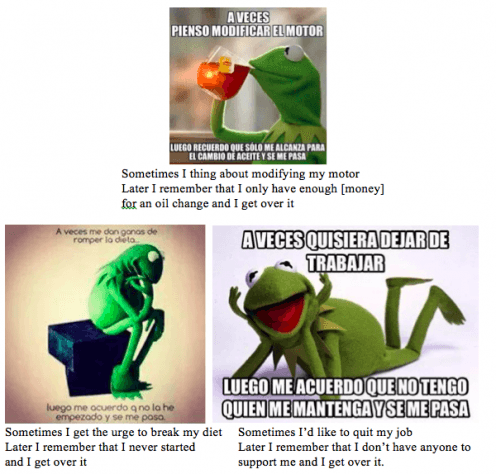Normativity on social media in Northern Chile
By ucsanha, on 7 January 2015
As many entries in the blog affirm, local cultural aspects are often reflected or made even more visual on social media. As I have written before of my fieldsite, there is a certain normativity that pervades social life. Material goods such as homes, clothing, electronics, and even food all fall within an “acceptable” range of normality. No one is trying to keep up with Joneses, because there’s no need. Instead the Joneses and the Smiths and the Rodriguezes and the Correas all outwardly exhibit pretty much the same level of consumerism. Work and salary similarly fall within a circumscribed set of opportunities, and because there is little market for advanced degrees, technical education or a 2 year post-secondary degree is usually the highest one will achieve academically. This acceptance of normativity is apparent on social media as well.
One particularly amusing example of this type of acceptance is especially apparent from a certain style of meme that overwhelmed Facebook in October of 2014. These “Rana René” (Kermit the Frog, in English) memes expressed a sense of abandoned aspirations. In these memes, the frog expresses desire for something—a better physique, nicer material goods, a better family- or love-life—but concludes that it is unlikely to happen, and that “se me pasa,” “I get over it.”
Similarly, during June and July of 2013 a common form of meme contrasted the expected with reality. The example below demonstrates the “expected” man at the beach—one who looks like a model, with a fit body, tan skin, and picturesque background. The “reality” shows a man who is out of shape, lighter skinned, and on a beach populated by other people and structures. It does not portray the sort of serene, dreamlike setting of the “expected.” In others, the “expected” would portray equally “ideal” settings, people, clothing, parties, architecture, or romantic situations. The reality would always humorously demonstrate something more mundane, or even disastrous. These memes became so ubiquitous that they were even used as inspiration for advertising, as for the dessert brand below.
For me, these correspondences between social media and social life reinforce the assertion by the Global Social Media Impact Study that this type of research must combine online work with grounded ethnography in the fieldsite. These posts could have caught my eye had I never set foot in northern Chile, but knowing what I know about what the place and people look like, how they act, and what the desires and aspirations are for individuals, I understand the importance of these posts as expressing the normativity that is so important to the social fabric of the community.
3 Responses to “Normativity on social media in Northern Chile”
- 1
- 2
-
3
Ademir wrote on 27 November 2015:
These themes are very fun, give lots of laughs with some. It is true that always has a kernel of truth with a mixture of humor.
 Close
Close







RT @UCLSocNet: Normativity on social media in Northern Chile http://t.co/8pN4PbuCvS